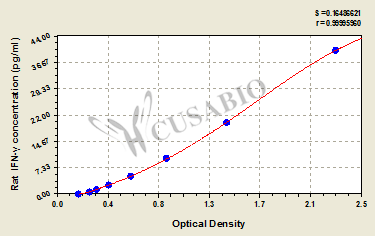The product CSB-E04579r is a ready-to-use microwell, strip plate ELISA kit for quantitatively analyzing the presence of the IFNG in different biological samples, including serum, plasma, and tissue homogenates. This IFNG ELISA kit specifically recognizes the rat IFNG in the sample. It adopts the Sandwich ELISA technique in conjunction with antibody-antigen specific binding and an enzyme colorimetric reaction to indicate the presence of rat IFNG and quantitatively measure the concentration of IFNG in the samples.
IFNγ (IFNG) is a pleiotropic molecule with associated antiproliferative, pro-apoptotic, and antitumor properties. It plays a profound role both in innate and adaptive immunity that facilitates host protection. IFNγ can exhibit its immunomodulatory effects by increasing antigen processing & presentation and leukocyte trafficking, inducing an anti-viral state, boosting the anti-microbial functions, and influencing cellular proliferation and apoptosis. IFNγ binds to IFNGR1 and IFNGR2 and then activates JAK1/2, leading to the activation of STAT1-GAS-IRF1 cascade that promotes gene transcription or stimulation of STAT1-PI3K-Akt axis that results in the implication of mTOR in interferon signaling. Abnormal synthesis of IFNγ has been related to the pathogenesis of chronic diseases, such as inflammatory bowel disease and diabetes.






